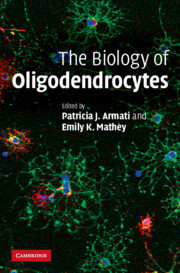Book contents
- Frontmatter
- Contents
- Preface
- Contributors
- 1 CNS oligarchs; the rise of the oligodendrocyte in a neuron-centric culture
- 2 Comparative biology of Schwann cells and oligodendrocytes
- 3 Control of oligodendrocyte development and myelination in the vertebrate CNS
- 4 Molecular organization of the oligodendrocyte and myelin
- 5 The genetics of oligodendrocytes
- 6 Immunobiology of the oligodendrocyte
- 7 Oligodendrocytes and disease: repair, remyelination and stem cells
- 8 Glial progenitor cells and the dynamics of the oligodendrocyte and its myelin in the aged and injured CNS
- 9 Oligodendroglial pathology in multiple sclerosis
- 10 Glutamate receptors, transporters and periventricular leukomalacia
- References
- Index
- Plate section
7 - Oligodendrocytes and disease: repair, remyelination and stem cells
Published online by Cambridge University Press: 05 August 2012
- Frontmatter
- Contents
- Preface
- Contributors
- 1 CNS oligarchs; the rise of the oligodendrocyte in a neuron-centric culture
- 2 Comparative biology of Schwann cells and oligodendrocytes
- 3 Control of oligodendrocyte development and myelination in the vertebrate CNS
- 4 Molecular organization of the oligodendrocyte and myelin
- 5 The genetics of oligodendrocytes
- 6 Immunobiology of the oligodendrocyte
- 7 Oligodendrocytes and disease: repair, remyelination and stem cells
- 8 Glial progenitor cells and the dynamics of the oligodendrocyte and its myelin in the aged and injured CNS
- 9 Oligodendroglial pathology in multiple sclerosis
- 10 Glutamate receptors, transporters and periventricular leukomalacia
- References
- Index
- Plate section
Summary
INTRODUCTION
In many diseases of the CNS, oligodendrocytes are damaged and lost, and the related demyelination and consequent conduction block play a major role in producing neurological disability. In some, oligodendrocyte injury is secondary to non-specific insults, such as trauma or ischemia. In others, more specific or targeted oligodendrocyte damage occurs. Amongst the latter, multiple sclerosis (MS) is perhaps paradigmatic.
In MS, however, partial remyelination is conspicuous in many lesions, and is thought to contribute significantly to lasting recovery from acute relapse; it is also likely to contribute to the preservation of axons, and in this way to help reduce the accumulation of permanent neurological dysfunction. However, the progression of the disease, with relentlessly accumulating disability and handicap seen in the majority of patients with long-standing disease – and all with primary progressive MS – implies that reparative processes are overwhelmed or in some other way ultimately fail.
In this chapter, the biological background to oligodendrocyte and myelin repair in MS is briefly considered, and the reasons for the failure of more widespread and lasting tissue repair are explored. Experimental studies provide clear evidence that cell therapies to replace oligodendrocytes can be highly successful in promoting remyelination, but whether these can realistically translate into clinical management remains open to serious question. This said, few areas of emerging technology have commanded as much excitement in the past few years as that of stem cells and their potential therapeutic exploitation in an enormous range of currently incurable diseases.
- Type
- Chapter
- Information
- The Biology of Oligodendrocytes , pp. 137 - 153Publisher: Cambridge University PressPrint publication year: 2010

